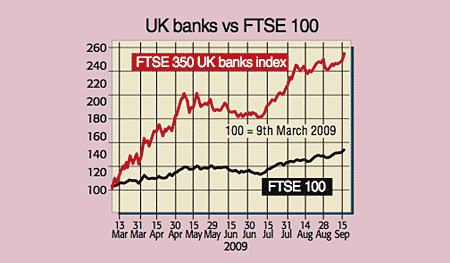
What’s the best company in Britain right now? You could make a case for Tesco, the sleek juggernaut of the retailing sector, now pushing aggressively into financial services. You could make just as persuasive a case for BP, the oil giant holding its dividend steady despite falling oil prices, and making big new finds in the Gulf of Mexico. You could equally well make a case for any one of a dozen retailers, miners, drugs or telecoms giants.
But the market has a different answer: Lloyds Banking Group. The bombed out, debt-laden, strategically muddled combination of Lloyds TSB and the wilfully mismanaged train crash that was HBOS is rated, by the market anyway, as the company to back.
Take a look at the performance chart for the stockmarket rally of the last six months (below). It has been led by banking stocks, such as Lloyds, and the equally debt-riddled Royal Bank of Scotland. Much the same is true in America: the S&P has been driven up by such paragons of financial reliability as Fannie Mae and Freddie Mac, as well as banks such as Goldman Sachs, which may be minting money right now but were on the brink of insolvency only a year ago. It is impossible to put a sensible valuation on most of those banks. So the fact they are leading the upswing perfectly illustrates how the markets have lost touch with reality in the last few weeks.
Nowhere is that clearer than in the companies that have been leading the FTSE 100 index back up to the 5,000 mark. Take Lloyds, for example. Its shares have recovered from slightly less than 25p earlier this year, to more than £1 now, quadrupling in value. Likewise, RBS went all the way down to 10p a share, but is now back above 50p. That matters for the index – the banking sector, even in its much reduced state, still accounts for 16% of the FTSE. The rally has, to a large extent, been about the recovery of the banking stocks.
Much the same is true in America. The two wholesale mortgage lenders, Freddie Mac and Fannie Mae, probably the two firms most exposed to the whole sub-prime debacle, saw their shares triple in value in the last month. The shares of the big Wall Street players, such as Goldman Sachs, have done just as well. Goldman is up from less than $60 at the start of the year to more than $170 now. Morgan Stanley has recovered from less than $8 to almost $30. Just as in Britain, the rally is largely about the recovery in the value of financial stocks. And yet how can we rationally come up with any meaningful valuation of companies that are, in effect, wards of the state?
Let’s focus on the two big British banks. The future of Lloyds and RBS is so cloudy that it is very hard to take any rational view of what the future might hold for them. What, for example, will the government do with its stakes? Will the state-owned shares eventually be sold to the public, in a re-run of the mass-marketed privatisations that marked the last Conservative government? Will the state hold onto its shares indefinitely, gradually turning the banks into utilities, or instruments of social engineering? Will more radical options, such as turning the banks back into mutually owned societies, be considered? Right now, no one has the foggiest idea.
No one really knows what kind of losses might still be racked up either. The credit-rating agency Moody’s reported this week that the British banks were only half-way through reporting the losses they were likely to suffer as a result of the recession. They’ve already chewed up £110bn in losses. But another £130bn is still to come, it reckons, as the downturn ravages the value of commercial property, to which both Lloyds and RBS are heavily exposed.
Nor does anyone really know what kind of regulatory structure may emerge. It isn’t clear whether the European Union’s competition rules will allow Lloyds to control more than 30% of the British banking market long-term (hopefully it won’t). Or whether rules preventing unfair state-aid will be applied to RBS. Exactly the same doubts surround the American and European banks that have been soaring in value over the past six months. In reality, the value of these companies is a complete mystery to everyone, including the people in charge of them. It is certainly a mystery to investors.
True, there is a big element of bounce-back. The banks aren’t closing down and the global economy has averted a re-run of the great depression. The fears of earlier this year have turned out to be exaggerated. That accounts for some of the recovery. But markets are meant to be forward-looking. And while the future is always to some degree unknowable, most companies can at least have a rough idea what their sales and profits might be in two or three years’ times. The banks have none at all.
The trouble is, many of the prices being set in this rally are quite literally a shot in the dark – and one probably made by a blind man aiming at a black cat. And that isn’t much of a basis for continuing strength. The rally may well continue. But so flimsy are its foundations that there is little reason to assume it will.